#oura cathedral
Text
Foreign Influence
Like many North East Asian countries, Japan was quite insular when it came to trade with western nations. During the Edo period, under the rule of the Tokugawa shogunate, though, nearly all foreign nationals were banned from entering Japan. At Dejima, an artificial island built off Nagasaki, I learned that despite these restrictions, Japan did occasionally trade with the Portuguese. This petered off and the Dutch stepped in. And, in fact, it was Japan's relationship with the Dutch that saw the nation expand its knowledge and begin to incorporate more Western-style thinking to medicine, science and technology.
Later, as the history books tell us, Japan fully opened up in the Meiji era and beyond.
Waking up early, after enjoying a delicious hotel breakfast, bleachpanda and I headed to Dejima (which, thankfully, was very close to our hotel at Shinchi Chinatown). After paying the entry fee, we meandered through the reconstructed island, peeking into warehouses and exhibits showcasing the history of the place.
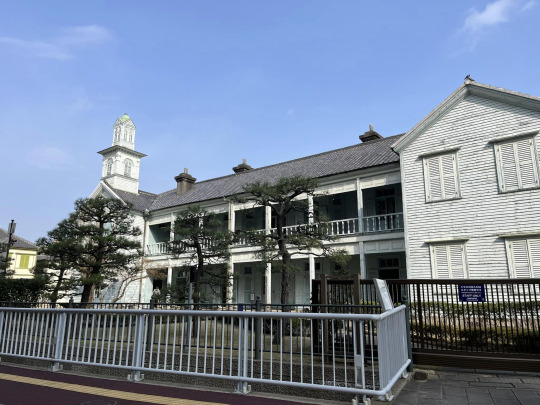
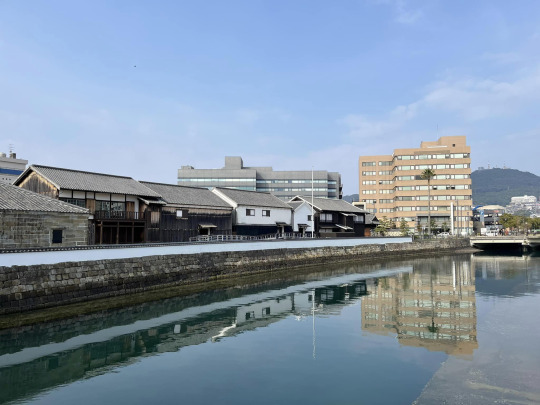
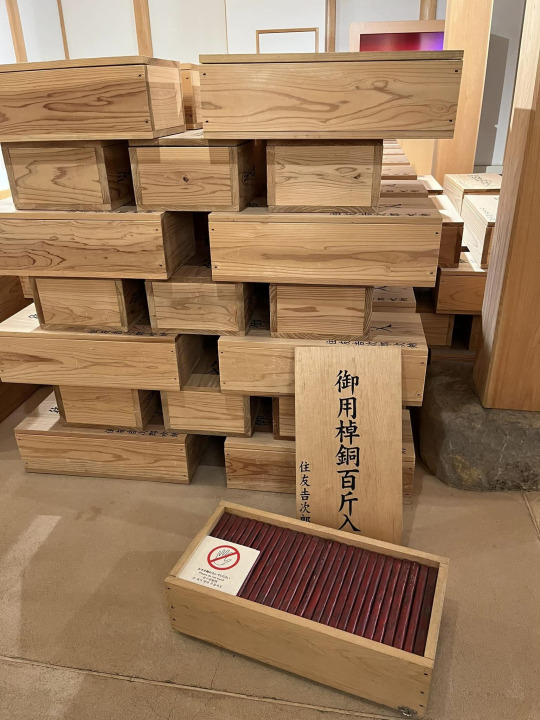

These were usually in the form of videos or placards on the side. Unfortunately, most of them were solely in Japanese, making it harder for me to appreciate the items on display - although most were very identifiable.
What stood out to me, as we were making our way through the recreated warehouses, was the focus made on the copper the Japanese traded with the Dutch, and how these were smelted into the form of bars, which were later weighed, before being sealed into their boxes. The sheer number of copper that went through Dejima was extensive.
Then, of course, there were the large number of pottery on display. Like many nations, the Dutch also favoured the iconic blue and white ceramics from China. And in Nagasaki, Japanese artisans were encouraged to imitate the style for the benefit of trade.
All in all, Dejima was a worthwhile place to visit as it served as Japan's gateway to the wider world despite the restrictions imposed by the Tokugawa shogunate at the time. But it also spoke of how the Western world engaged with other nations in the latter half of the Age of Exploration. Plus, there's a mini Dejima one can look out over! And there were even models of ships and one of the very first badminton racquets!
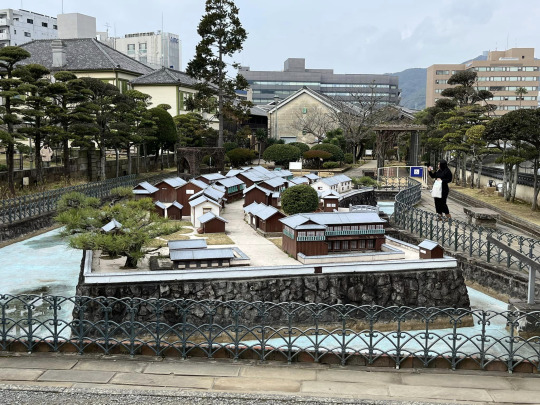
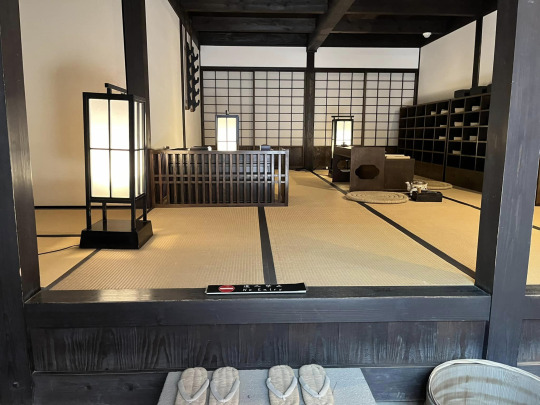
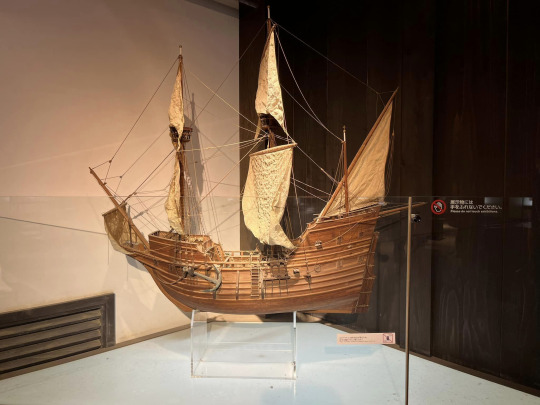
From Dejima, bleachpanda and I headed to Glover Garden. What we hadn't expected when we got there was just how extensive the gardens were. Based on the map of Nagasaki I obtained while at the JR station, I had initially assumed Glover Garden would be a small place and within 10 minutes, I'd have snapped all the pictures I would need. But Glover Garden, to my dismay, was a sprawling complex dedicated to a Scottish merchant, known for bringing news of the Industrial Revolution to Japan.
Thomas Blake Glover, for whom the Gardens are named after, came to Japan in 1859 and founded Glover and Co. three years later. He engaged in trade with the locals and would contribute to the modernisation of Japan including the construction of Kosuge Slip Dock and cooperating with the Saga domain to establish Japan's first modern coal mine.
More importantly, though, Glover Garden also hosted the oldest Western-style house in Dejima!

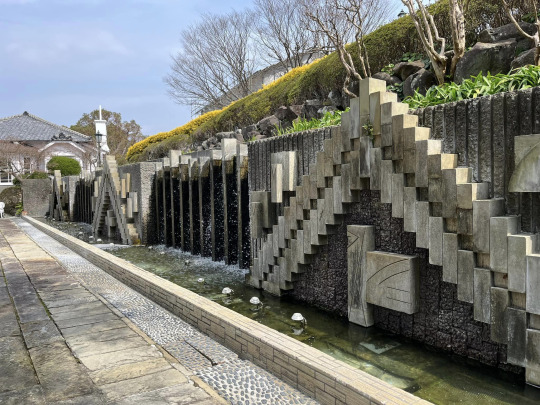

By the time we finished touring the gardens, it was nearly 2 PM (far later than I had initially anticipated). And so, wanting to enjoy a decent meal, bleachpanda and I headed to a family restaurant nearby: Bikkuri Donkey. which is known for its hamburger steaks and patties.
Once full, we then headed to Oura cathedral. Alas, it cost 1000 Yen for admittance. Given that bleachpanda and I live in Australia were there are many cathedrals open to the public - and which many might argue are more impressive in design (St Mary's Cathedral and St Andrew's)- I couldn't justify the price for entry. Refusing to pay, bleachpanda and I spent the rest of the afternoon ducking into the local shops that lined the street leading up to the cathedral wherein quite a few purchases were made - although only for small things.
After pulling bleachpanda away from purchasing even more earrings she didn't need, we retreated back to our hotel to count our spoils before heading out again to check out Amu Plaza, located next to Nagasaki JR station (and where I took a photo of the red dragon chasing the golden ball). As usual, bleachpanda spent more than expected on her small trinket accessories while I had a look at belts because I wanted to replace the one I was wearing as it was falling apart at the seams.
It should be noted that my purchases cost me less than what bleachpanda ended up spending. So, one more point to Kyndaris!
We then had a simple dinner at a restaurant adjacent to the station before heading back to Candeo Hotel for a good night's rest. After all, we were headed to Hiroshima the next day! And our very first Pokemon Centre stop (I tried to convince bleachpanda to make a pitstop at Fukuoka again but she refused).
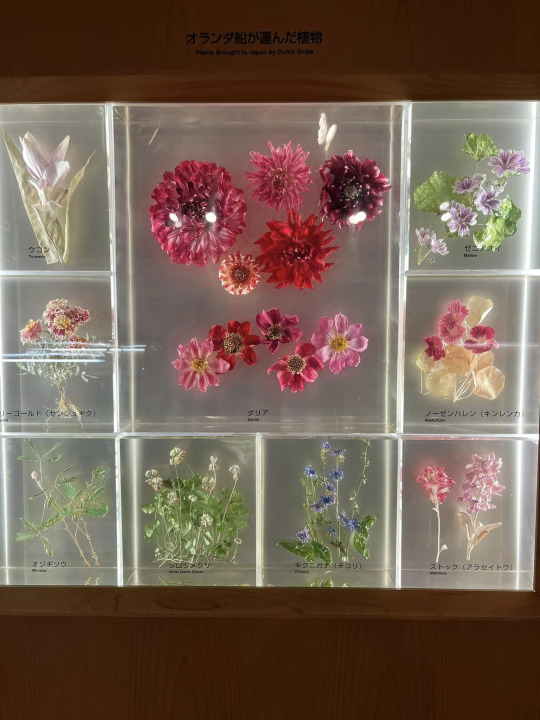
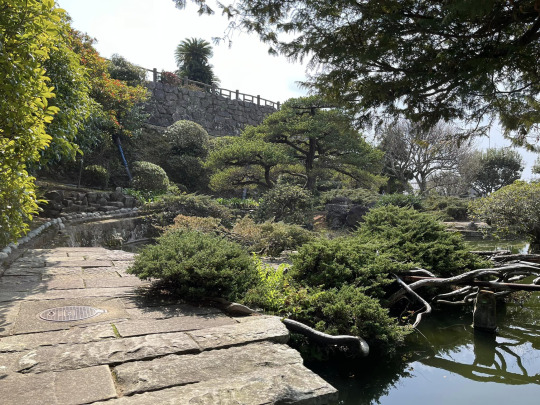

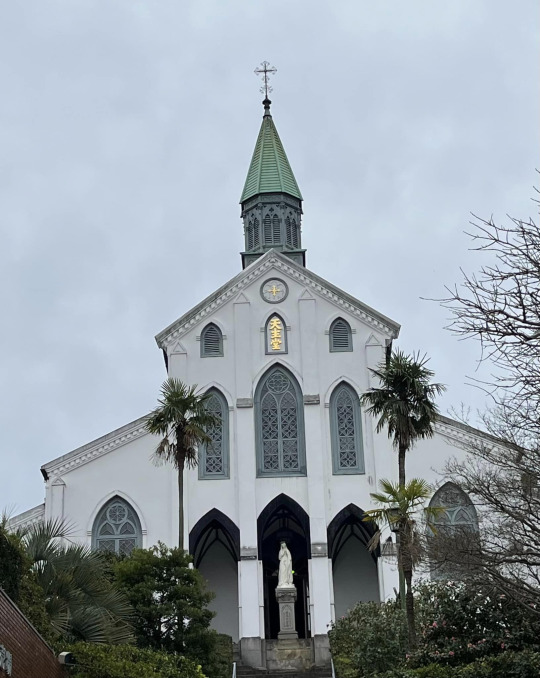
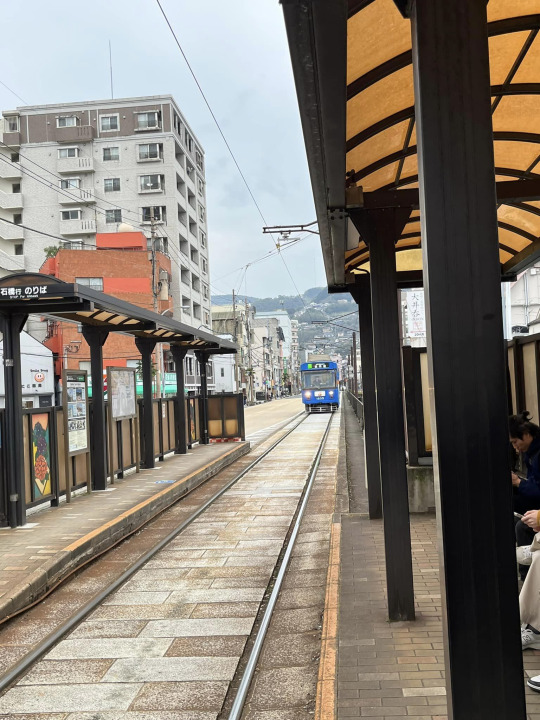
3 notes
·
View notes
Text
instagram
Oura cathedral
Hidden Christian sites in Nagasaki region.
Deep and sad history is here.
大浦天主堂
長崎にある隠れキリシタン
深く悲しい歴史がここにある。
#kanji#漢字#単語#日本語#learning japanese#長崎#大浦天主堂#クリスチャン#nagasaki#christian faith#Oura cathedral#Instagram
2 notes
·
View notes
Photo

異国情緒と西洋建築
長崎
長崎は長い間、西洋諸国との交流が盛んであり、その影響を受けた異国情緒溢れる景観や洋風建築が特徴です。以下に、長崎の異国情緒と洋風建築に関する詳細を述べます。
1. 出島(でじま):
出島は、江戸時代にオランダ商館が設けられた、人工の島です。長崎港の中心に位置し、当時オランダ人が長崎に滞在していた唯一の場所でした。この島は高い塀で囲まれ、海外からの交易が行われた場所であり、西洋文化が最初に日本に入ってきた場所の一つです。
2. グラバー園:
グラバー園は、英国人商人トマス・グラバーが築いた庭園と洋館です。洋風の建物が点在し、バラや樹木が植えられた美しい庭園が特徴です。海外からの情熱的な風情が感じられる場所で、現在は長崎の代表的な観光スポットの一つとなっています。
3. オランダ坂:
オランダ坂は、長崎市の中心部にある石畳の坂道で、西洋風の建物やレストラン、カフェが軒を連ねるエリアです。坂道に沿って建てられた洋風の住居や店舗があり、異国情緒を感じさせる雰囲気が漂っています。
4. 洋風建築の教会:
長崎にはキリスト教の歴史的な背景もあり、洋風の教会や聖堂が多く存在します。長崎には長崎大浦天主堂や十六聖人堂など、異国情緒溢れる西洋風の建築物が多く残っています。
♪♫♬🎤🎹🎶♪♫♬🎤🎹🎶♪♫♬🎤🎹🎶♪♫♬🎤🎹🎶
Exoticism and Western architecture
Nagasaki
Nagasaki has long had active exchanges with Western countries, and is characterized by its exotic landscape and Western-style architecture. Below, we will provide details about Nagasaki's exotic atmosphere and Western-style architecture.
1. Dejima:
Dejima is an artificial island where a Dutch trading post was established during the Edo period. Located in the center of Nagasaki Port, it was the only place where Dutch people stayed in Nagasaki at the time. This island is surrounded by a high wall and is a place where trade from overseas took place, and is one of the places where Western culture first entered Japan.
2. Glover Garden:
Glover Garden is a garden and Western-style mansion built by British merchant Thomas Glover. It is dotted with Western-style buildings and features beautiful gardens planted with roses and trees. It is a place where you can feel the passionate atmosphere from overseas, and it is now one of Nagasaki's representative tourist spots.
3. Holland Hill:
Orandazaka is a cobblestone slope in the center of Nagasaki City, an area lined with Western-style buildings, restaurants, and cafes. There are Western-style residences and shops built along the slope, giving it an exotic atmosphere.
4. Western-style church:
Nagasaki has a historical background of Christianity, and there are many Western-style churches and cathedrals. Nagasaki is home to many exotic Western-style buildings, such as Nagasaki Oura Cathedral and the Hall of the Sixteen Saints.
1 note
·
View note
Photo
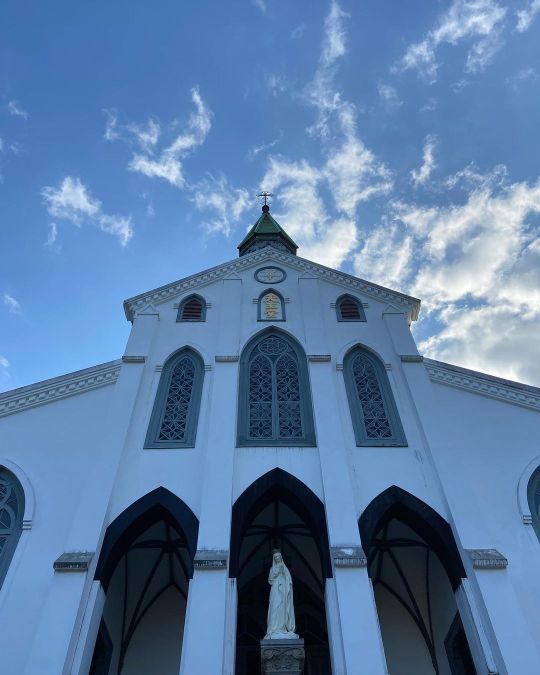
大浦天主堂 Oura Cathedral #oura #ouracathedral #ouracathedralchurch #nagasaki #kyushu #japan (at 大浦天主堂) https://www.instagram.com/p/Cmojgcsygwk/?igshid=NGJjMDIxMWI=
0 notes
Text
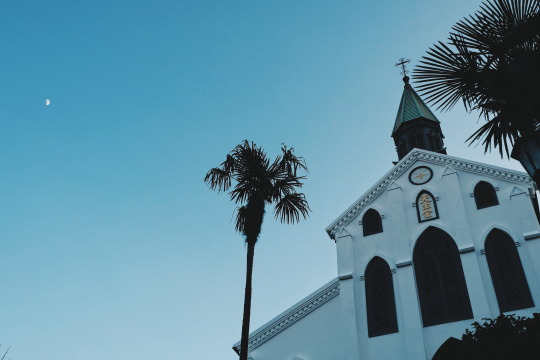
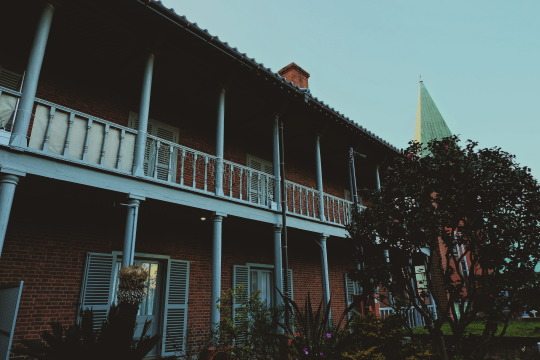
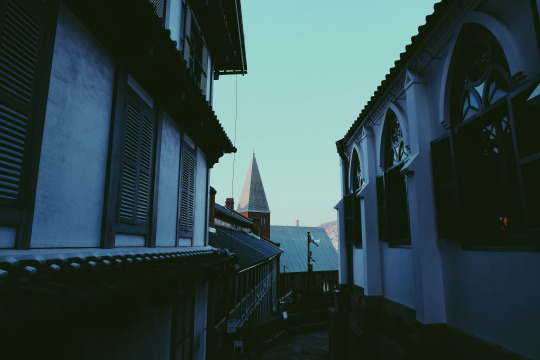
#original photography on tumblr#photography#japan#japanese#Oura Cathedral#church#catholic#catholic church#historic building#japanese landscape#landmark#landscape#blue#Nagasaki#Nagasaki city#Oura#world Heritage#Churches and Christian Heritage Sites in Nagasaki#大浦天主堂#教会#カトリック教会#長崎#長崎市#世界遺産#長崎の教会群とキリスト教関連遺産
72 notes
·
View notes
Text
Nagasaki
Friday 8 March
We have sailed around the bottom of Kyushu island, Japan’s most Southerly island and are now on the western coast at the town of Nagasaki.
Nagasaki was the site of the 2nd Atomic Bomb that effectively ended WWII on 9 August 1945 so is steeped in history, albeit modern warfare history.
When the bomb was dropped with the enormous loss of life it was said that nothing would grow again in at least 70 years, now 73 and a bit years on, the City is flourishing and indeed some plants started growing again only a few weeks after the bomb was dropped.
Nagasaki tram
We are moored close into the town and as we have an afternoon tour booked, take a stroll around the immediate area with it’s quite ancient looking tram a few shops and Oura Catholic Cathedral, the oldest wooden church built in 1865 which withstood the bomb albeit with some damage.
Oura Catholic church, Nagasaki
The shops in the area near the port were selling Japanese cartoon memorabilia or so it seemed, nothing to get excited about.
Our tour this afternoon is to Mount Inasa which has a commanding view of the valley.
From the observation deck at Mt. InasaP overlooking Nagasaki
The coach drops us at the Cable Car station where we ascend to more or less the top as the last bit is by lift to a walkway through a car park.
Another lift takes you to the top although if you are able, the 79 steps up the broad circular stairwell is achievable in about the same time.
The cable car attendants are typical Japanese friendly staff, bowing to you and pointing to where the cable car is going.
One of the reasons why the atomic bomb damage over Nagasaki was not as widespread as Hiroshima is the geography with the blast being confined to the valley.
Japanese housing estate – steep hillside variety
Housing was scattered around us by the Cable car, very steep steps to the houses and no car parking.
Japan has an issue with housing as no one now wants to live in such housing, preferring modern houses so these are hard to sell.
Japanese shrine
Once down from the Mountain, we viewed some of the memorials and shrines although for once in Japan, there was not a lot of English in the descriptions. (Generally, they had a good translation.)
We then continued our tour stopping at The Peace Park. Unfortunately, the Peace Statue and the water fountains at the Peace Park were both under renovation.
Peace Statue undergoing refurbishment
It was somewhat poignant that nearly all of the memorials in the Peace Park were from countries with Communist sympathies.
The Peace Statue dates from August 1955, the 10th Anniversary of the Bomb.
The elevated right hand points to the threat of Nuclear weapons and the outstretched left symbolyses tranquility and World Peace.
I am not sure what I was expecting but it was not as dramatic as I had anticipated.
Interestingly, a crew member on the tour with us said she had visited the Kamikaze museum the previous day which she found very moving with the other side of the war being told.
Original parts of the church not destroyed in 1945
Our final stop of the day was at the Peace Museum. Sadly not enough time was allowed here and in any event, with no internet for about a week, advantage was taken of the good Internet there.
The Museum was approached from across a road from a park which is directly below where the bomb exploded and of course has many reminders.
Part of the church that stood there still remains and a new statue erected at the 50th anniversary.
Description of the 50th Anniversary monument
Once inside, the museum there is a great deal to see including the church clock that was stopped as the Bomb went off and has been kept in it’s condition as it was at the time, a reconstruction of the church and of course many photos of the devastation that occurred.
A very moving experience even after so many years. One of the most poignant comments though was from the tour guide who when talking about the bomb said that as a result, Japan surrendered.
That must still hurt a very proud nation to have to say that.
Photographs of the devastation
We are back to the ship now, passing the one pillar of the San Shinto Shrine that remained after the blast.
This was an exceptionally moving tour and experience.
Let us hope that this is a salutary lesson to all countries and that devastation like this never happens again. I think I will remember this tour for a very long time.
Entertainment tonight was from the Headliners with a new show based on The Greatest Showman – a new show but the same type of dance routines as we sail off towards Hong Kong.

Date & time of the devastation
Nagasaki, Japan Friday 8 March We have sailed around the bottom of Kyushu island, Japan’s most Southerly island and are now on the western coast at the town of Nagasaki.
#9 August 1945#Atomic Bomb#Japan#Kyushu Island#Mount Inasa#Nagasaki#Oura Catholic Cathedral#Peace Museum#Peach Gardens
0 notes
Photo

: Bless us. Nagasaki, Japan, 2019 : 先週は長崎にも 天気が良くて心地良かった 長崎歩き、個人的に福岡の次に 九州出歩いて楽しいのって 長崎だと思っています。 : #Japan #日本 #長崎 #Nagasaki #Travel #大浦天主堂 #sunny #white #architecture #shine #favorites #instagram #今日もx日和 (Oura Cathedral) https://www.instagram.com/p/BvoQNbPltDv/?utm_source=ig_tumblr_share&igshid=1hbrnifmghz53
1 note
·
View note
Photo
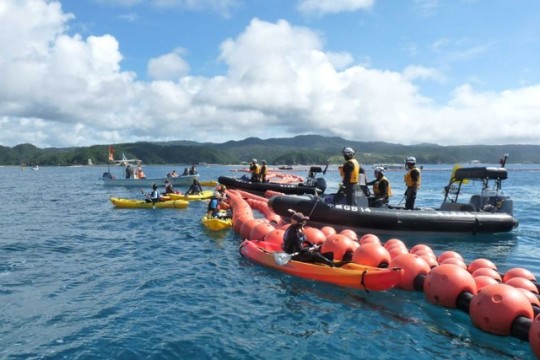
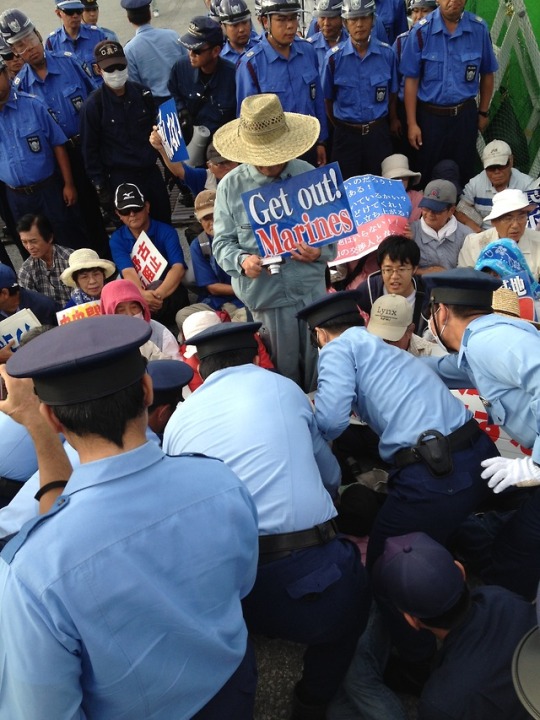
By Jon Letman (https://fluxhawaii.com/the-scourge-of-oura-bay/)
It’s a blistering hot day when Japanese Coast Guard officers pack into a dozen black Zodiac inflatable boats, determined to deter yet another wave of protestors. The enforcers are dressed in all-black dive gear with black facemasks, sunglasses, and helmets. Cameras mounted on their shoulders record protesters floating in kayaks alongside small motorboats flying rainbow peace flags over Okinawa’s Oura Bay. After a tense hour, the protesters rally. Some paddle their kayaks over the orange buoys that act as a barrier, while others swim beneath it, racing toward a four-legged platform used for sea floor construction. The Coast Guard quickly surrounds and apprehends the protestors, hauling them back to the shore.
The floating orange buoys at Oura Bay mark one of three places in the sparsely populated district of Henoko, where these forces have been facing off regularly since 2004. This clash is centered on the fact that the buoys form the exclusion barrier where a new U.S. military base, the Futenma Replacement Facility, is slated to be built in order to relocate an existing base, the Marine Corps Air Station at Futenma, which has been in service since 1945. The move towards re-militarizing Oura Bay has returned to Japanese and American foreign policy agendas as tensions continue to rise among Asian countries over territorial claims on the South China Sea.
After World War II, the United States entered into an occupation of Japan, leading to the independence of the country under specific conditions. One of those conditions was that the U.S. military continue its rule of Okinawa—the archipelago of islands south of mainland Japan—which kept the main Japanese islands largely free of U.S. military presence. A 1960 treaty upheld that division, confirming the U.S. occupation of Okinawa and its use of bases elsewhere in the country. Because of this agreement, Okinawa is home to nearly 75 percent of all U.S. bases (there are 32 bases on the island) and about half the troops in Japan—this despite the fact that Okinawa accounts for less than 1 percent of Japanese territory. To put this into perspective, Okinawa Island is almost 20 percent smaller than Kaua‘i, yet the island is home to nearly 1.4 million people. To the north and south of the Henoko-Oura area are the Central and Northern Training Areas, which occupy more than 37,000 acres, including training grounds for urban and jungle warfare and 59 military landing zones.
Like Hawai‘i, Okinawa is a tropical archipelago endowed with rich biodiversity and an indigenous population deeply connected to the land. Along Oura Bay’s shoreline, legions of tiny blue soldier crabs march across the mud, black-naped terns nest, and stark white egrets search for food. Silky grey mudskippers, a critically endangered species, and more than 2,000 species of mollusk rely on these same tidal flats for their survival. Oura Bay is also home to at least 10 species of sea grass that attract dugong, a large, lumpy marine mammal similar to a manatee that has been red-listed by the International Union for Conservation of Nature as “vulnerable.” Sensitive to noise, it appears that the dugong may have already left the bustling area.
A variety of flora and fauna thrives in, and may disappear from, the area—a region which includes fringing coral reefs, mangrove swamps, mud flats, estuaries, and a rugged shoreline dotted with rocky outcrops and white coral sand beaches. “It’s just stunning,” says marine biologist Katherine Muzik, who lived in Okinawa for 11 years and dove extensively throughout the Okinawan archipelago. “The bay is on par with the best marine environments in Indonesia and the Great Barrier Reef,” she says. Muzik notes the more than 400 species of coral, a thousand species of fish, and 110 species of sea slugs present in the bay, explaining that “there’s nothing left like it in the entire [Okinawan] archipelago, which means there’s nothing left like it in all of Japan.”
At Cape Henoko, which juts into the bay, 21 million cubic meters of sand and soil are scheduled to be dumped in order to reclaim land for a new base. Environmentalists argue that this act would destroy the ecosystem. Henoko’s depths, which reach almost 200 feet, are one of the distinctive qualities that give the locale such biodiversity. Millions of tons of sand would alter the bay’s currents, which, in turn, would affect the amount of sunlight that penetrates the water, drastically altering its clarity and imperiling what Muzik calls “soaring cathedrals of blue coral.”
A dive team called Snack Snufkin has taken up the responsibility of documenting the rich marine life of the bay through its website ourawan.com, as well as informational brochures, photo exhibitions, and a new educational book. Botanist and diver Kenta Watanabe, a member of the dive team, says the group wants to use its scientific findings to educate the public on the uniqueness of the bay. “It provides many good habitats for various species,” Watanabe says. “The diversity of topography supports the diversity of marine creatures. We’ve found this place is very special.”
These divers aren’t the only people concerned over the Henoko plan. In 2013, the Ecological Society of Japan sent a letter to the Japanese Ministers of Defense and Environment requesting that the survey work for Henoko be stopped. Last year, 19 Japanese scientific organizations also signed a joint petition calling for the conservation of Oura Bay’s significantly high biological diversity. Polls consistently show the Henoko plan—with its proposed multiple helipads, 892-foot military-grade docking facilities, fuel and ammunition depots, and 5,900-foot V-shaped dual runways—is fiercely opposed by the majority of Okinawans.
The U.S. military says base opponents are in the minority, and insists that the American bases are vital to regional stability and the “common defense of Japan.” Speaking at Futenma air base, a Marine spokesman stressed the military’s role in providing humanitarian aid and disaster relief in places like the Philippines, Nepal, and elsewhere. Thousands of Japanese and Okinawans are also either employed by the U.S. military or work in fields that rely on its presence, including employment that ranges from working as private security guards to pouring concrete, providing heavy equipment, and installing and maintaining miles of fences that surround military sites.
Others in Okinawa welcome the U.S. presence for fear of China or North Korea, although many reject this stance, pointing rather to a centuries-long history when Okinawa had peaceful and prosperous relations with China during the period prior to Japan absorbing what was then the independent Ryukyu kingdom in the 1870s. Also, many Okinawans draw attention to the fact that the Chinese are already in Okinawa—doing business and supporting the tourism sector.
From an island perspective, this foreign military occupation is something with which many in Hawai‘i can relate. Our islands are home to one of the world’s largest Okinawan diaspora communities, and share long-established and cultural ties with Okinawa. It’s natural that the two island peoples have an affinity for and understanding of one another. In July 2015, Okinawa and Hawai‘i celebrated 30 years of sister-state relations. Okinawa is a place where the land and sea coexist in a fragile balance, one that is constantly challenged by external forces. We in Hawai‘i have seen this struggle play out within places of similar ecological fragility, like Mākua Valley, Kaho‘olawe, Pōhakuloa, and Ke Awalau o Pu‘uloa, which was transformed from the “breadbasket of O‘ahu,” a place of aquatic abundance, into what we all know it as today: Pearl Harbor. Like these sites, Oura Bay now finds itself similarly perched upon the edge of an uncertain future.
7 notes
·
View notes
Photo

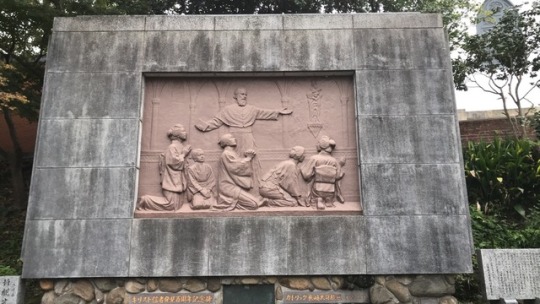

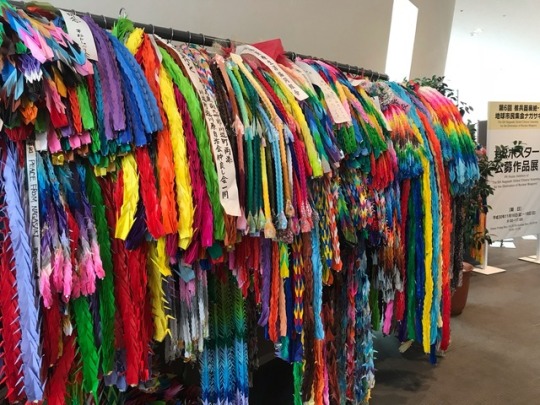
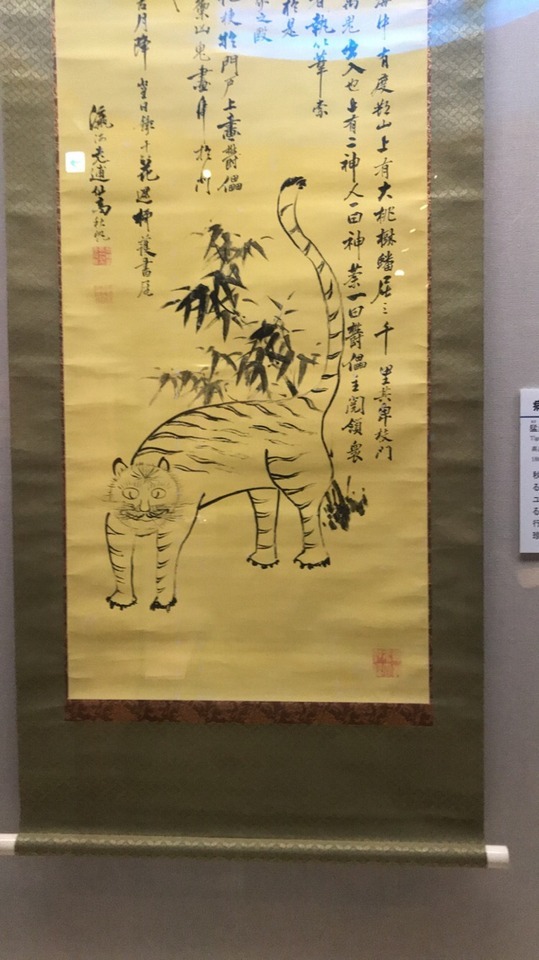
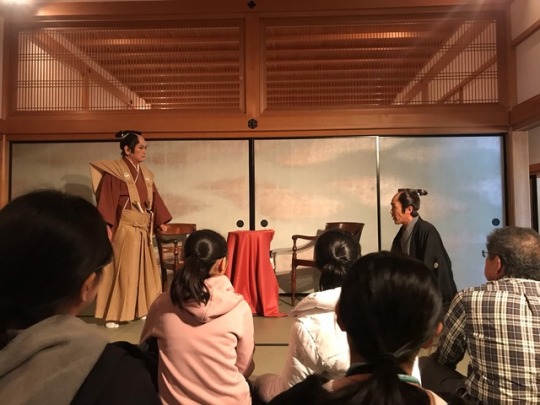
The Nagasaki fieldwork class took an all day trip to the Atomic Bomb Museum, the museum of history and culture and Glover garden (with a short look at Oura cathedral). The Atomic Bomb Museum was very somber, but l feel like it’s an important place to video when in Nagasaki along with the Peace Park. In a way I’m happy I waited towards the end of my trip to visit as I feel it wouldn’t have had the same impact if I had gone earlier.
1 note
·
View note
Text
Christianity in Japan Article:Part II
In Jesus’ Name, (R)Amen- Kaedama!!: Japan’s Dark History With Christianity
Christianity’s impact on Japanese culture is… debatable. Don’t get me wrong, it’s definitely there, but sometimes, it can be hard to clock. Traditions for Christian holidays like Christmas have changed to fit Japanese tastes past the point of recognition for most foreigners (“Christmas is Kentucky”, anyone?), and the aesthetics of Christianity seem to be embraced rather than for its ideologies. Previously, I discussed how the religion has permeated Japanese culture, as well as interviewing a Japanese Christian to learn more about contemporary Japanese views of Christianity. Through the interview, I could better understand not only Japan’s image of Christianity, but also how Japan viewed religion in general, and I hope some readers were able to, too.
But, the one thing I still didn’t really understand was why only 2% of the population identifies as Christian. It had been around in Japan since the mid-1500s, (almost 500 years!) and I knew that there were incidents like the 26 Martyrs, but that had happened 1597! What happened between then and now for Christianity’s growth in Japan to be so stunted? I took to the books, Internet, and articles, and as it turns out, Japan’s history with Christianity was far darker than I realized.
It all started out happily enough. After Portuguese traders, Antonio de Mota and Francisco Zeimoto, accidentally landed on Japan’s shores in 1543, the first Christian missionaries sailed from Portugal to Japan in 1549 and began working. Spearheading the effort was Francis Xavier, a Jesuit monk. Though evangelizing the Japanese people was the main goal, the Portuguese were keenly aware that establishing Christianity in Japan could help expand their trading territory further, and with that, the race to convert (and earn money) was on.
Unfortunately, initial efforts weren’t one hundred percent successful. In addition to the language barrier, missionaries had a hard time explaining Christianity to the Japanese, who questioned how a God who created everything, including evil, could be good. Most were indifferent, and tolerated the missionaries at best. Oda Nobunaga, the most powerful warlord at the time, supported their activities, but never converted nor pushed policies to further their work. Still, the missionaries managed to catch the attention of powerful people who wanted in on the trade and commerce they brought.
Shrewd shoguns gave some missionaries license to practice and teach in their territories in exchange for access to foreign goods, like silk and porcelain. Japanese people were seriously craving Chinese goods because China had stopped trading with Japan after pirate attacks, and Portuguese missionaries took the opportunity to motivate people to convert. Some daimyos even voluntarily converted so Portuguese traders would be more willing to trade with them. Seeing Portugal’s success, Spain eventually joined in too, sending over Franciscan monks to Japan. Slowly, but steadily, the Christian movement spread across Kyushu and Western Japan, reaching around 200,000 members by 1582.
Alas, missionaries’ progress slowed down when Japan was reunified under Toyotomi Hideyoshi, who feared the growing influence of foreigners in Japan. Hideyoshi’s suspiscions weren’t exactly unwarranted, either; much to his horror, Hideyoshi discovered that the Portuguese were purchasing Japanese people for the slave trade, and found foreigners’ disdain for Buddhist traditions troubling. Things came to a head after the San Felipe incident of 1596, when the Spanish trade ship, the San Felipe, crashed into Shikoku and was ransacked by the daimyo of the area.
To maintain diplomatic relations stable with Spain, Hideyoshi sent a representative to speak with the sailors of the San Felipe (up to this point, Hideyoshi had tolerated Christians, albeit with some side-eye). The following meeting proved to be a disaster, however, and the representative reported back what he understood from their conversation: that the influx of Christian missionaries in Japan was, in fact, phase 1 of a bigger plan to conquer Japan as a Spanish colony, and if all went to plan, Spain would be sending in conquistadors to finish the job.
Though it’s up for debate whether or not this plan was real, Hideyoshi was furious, and fearing loss of his power, he quickly issued an edict to remove all Christians from Japan swiftly. To discourage further converts, the warlord ordered the torture and execution of 26 Catholics, later known as the 26 Martyrs of Japan (remember them?). Unfortunately, their deaths were just the beginning, and over the next few decades, more than 200 Christians were executed, with many others persecuted for their faith.
Things went from bad to worse in 1637, under Tokugawa Ieyasu’s reign, when 16 year old (!) Amakusa Shiro led the Shimabara Rebellion against the current rulers. Many of the rebels, including Shiro, were Catholic, and had originally joined forces to fight against strict Christian persecution. The rebellion’s eventual failure, however, caused the deaths of an estimated 37,000 insurgents and instigated an even more serious crackdown on Christian activities. Those suspected of practicing Christianity were captured and could be tortured until they denounced the religion, or even executed.
One interrogation method was using a fumi-e (literally “stepping picture”). Authorities would order suspects to step on fumi-es, which were metal plates with pictures of Jesus Christ or the Virgin Mary on them. Those who refused to step on them would then be branded as Christians and be forced to recant their faith or else be tortured (or executed). Countless others had land confiscated or reduced to utter poverty, and the rampant persecution forced Christians to go into hiding, thus beginning the era of the kakure kirishitan, or “hidden Christians”, who practiced their faith in secrecy.
These hidden Christians took great, ingenious lengths to disguise their religion. Besides physically hiding their activities, they disguised anything to do with Christianity; holy iconography was hidden in statues of the Buddha and his disciples, Latin prayers were changed to sound more like Buddhist chants, and all printed word was eliminated, with followers resorting to orally reciting the scripture instead. Christianity became a tradition that was passed down generations, and this system continued until the Christianity ban was finally lifted during the Meiji Era.
Of course, the road to religious freedom was not a fast one. It all started with America making trade agreements with Japan. As the number of foreigners began to increase, Japan and America passed the Treaty of Amity & Commerce in 1858, which only allowed Americans to practice their religion and establish places of worship. Around this time, the practice of using fumi-e to out Christians was abolished as well. Although they weren’t allowed to spread the religion, Christian clergymen began to pour into Japan, and 15 years later, in 1873, Japanese people were granted religious freedom, too. This didn’t mean Japanese Christians weren’t persecuted anymore, though. Christians were still considered a liability to the government, and politicians were concerned that Christians would be difficult to control or subdue. Even more damning was that many Christians did not recognize the divinity of the Emperor, and as the country began to colonize Asia, one of the opposing groups was, you guessed it, Christians! As nationalism started sweeping up Japan, Christians became seen as more and more of a disgrace to society. In other words, Japanese Christians were still very much considered “the other” in their own country, but it would only get worse when Japan entered World War II.
Like with colonization, Japanese Christians were strongly against the war, much to the ire of more patriotic neighbors. Accounts of Christians receiving less rations or even being taken away by special forces are ample, and it wasn’t much better in the army, either; Christian soldiers were blacklisted if they were discovered, and labelled as a risk to the regime. Those who disobeyed orders because of their faith were severely punished or tortured.
The shift towards acceptance began once Japan surrendered and, more importantly, the Emperor renounced his divinity, a huge blow to national pride. Post-war Japan was a difficult landscape to navigate, and under General MacArthur’s project to suppress Japanese nationalism, Japan’s entire identity was changed or reevaluated. Traditions and values people had maintained for generations meant nothing when faced with hunger and violence in this new, unfamiliar environment that was once their home. Many turned to religion for solace, and with the large presence of foreigners, Christianity started to become a more widely accepted religion.
In my interview, I was told that many Japanese people saw Christians as too moralistic, uncompromising, and soft. However, through my research for this article, I realized that, actually, Christians have been seen as rebels, insurgents, and in some ways, revolutionaries. They chose to embrace the unfamiliar over traditional Japanese values, and when they were ordered to disconnect from the foreign influence of the religion, they disobeyed and tried to preserve their faith as much as possible. For a country like Japan, whose people pride themselves in maintaining traditions for decades or even centuries, what the early Christians did was absolutely radical. There are many, many valid problems with organized religion, and I myself don’t identify as Christian anymore despite my upbringing, but I am awed by the sheer perseverance of the Japanese Christians.
If you would like to learn more about Japanese Christians, you can find historically significant sights in Kyushu, like Oura Cathedral in Nagasaki, the oldest standing church in Japan. There are also several remote areas around Kyushu where kakure Christians practiced their faith in defiance of authority, such as Hirado island or the Goto islands.
Even though Christianity may never truly be a major religion in Japan, I hope and pray that the country’s promise to grant religious freedom to everyone, citizens and foreigners, will never be broken. Amen.
0 notes
Text
Post#7 Nagasaki 長崎市 @ Belleview Nagasaki Dejima ホテルベルビュー長崎出島
Day 1
After a ferry ride
oura church 大浦天主堂(てんしゅどう) Ōura Cathedral
After breakfast he headed for the Nagasaki’s Peace Park
and the Atom Bomb Museum
walked upstairs
Chinatown
Daisy Hill
day 2
The next day we bought a tram pass and left for the 26 Martyrs Memorial & Museum. There were a number of artifacts, including the remains of the original Martyrs themselves. Next was the Dejima Museum, created in memory of an artificial island that served as an old dutch trading post. A to scale model was made to show off Dejima as it was the only trading port of it’s time that dealed with western culture. The group then split up and had lunch, I tried Whale katsu a schnitzel style whale steak that I quite enjoyed. Similar flavour and texture to veal but with slightly fishy taste. The group was left free to explore so I caught a tram around Nagasaki, then I did one of a favourite things to do in Japan, went searching for Sakaya’s to find some rare old whiskies. I picked a direction and stubled upon a tiny sakaya. The shopkeeper was so nice I tried my hand at conversation and she was very willing to talk with my patchy Japanese. I asked about a few things, then she brought out some small bottles of whisky I recognised straight away, after asking for and purchasing two of the three she had available. She then offered me the third for free. These bottles were older than myself and priceless to some people. Japan is filled with so many tiny local shops rather than large warehouse style supermarkets. It is unheard of in Australia to have such small shops that rely on locals. After receiving my gift she then went on to mention her shop would be closing some time next year. The shop was quite far away from main streets so I didn't run off much tourism sales and the local sales were not enough for rent. I left the store bittersweet hoping Japan doesn't turn to large warehouse style stores. I returned to the group for dinner and caught the free shuttle bus up to ふくの湯温泉 Fukunoyu Onsen. We started with an amazing buffet with a beautiful view over Nagasaki atop 稲佐山 Mt Inasayama, then proceeded to the onsen. It had a large variety of baths and even a salt sauna, but the attraction to me was the view. As you soaked in the hot bath you could see Nagasaki lit up from the city lights a great way to finish the night.
Day 3
late start
went shopping in small group
had coco ichiban curry for lunch
went out to dinner with uni students
Day 4
眼(め)鏡橋(がねばし) Spectacles Bridge
originally built in 1634 and so-called because the reflection of the arches in the river looks like a pair on Meiji-era spectacles.
went shopping in s small group caleb and alex
met leigh crossing the street want to go to island
went to 2 onsen and had aweomse sushi at local restaurant
caught ferry back biguasu known for its large stern
chinese confusious temple
Dinner will be at a restaurant on the boardwalk overlooking the beautiful Nagasaki Harbour tonight.
0 notes
Photo


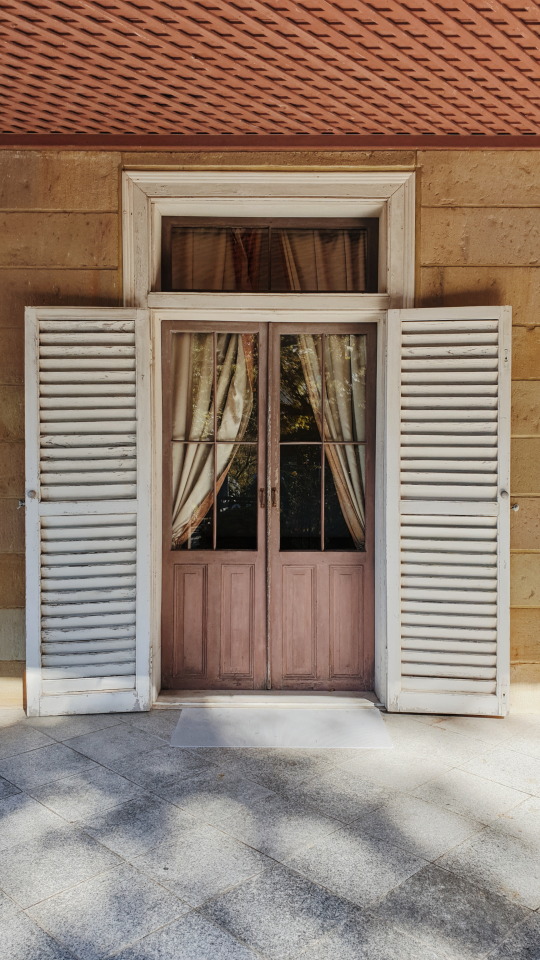



Day 16: Nagasaki pt.1
Events:
My free day! Filled with cool architecture!
I went to Glover Gardens and Oura Cathedral and museum with Leigh Sensei.
Split off to go my own way, and visited the Holland slope with a collection of Dutch Houses.
Impressions:
I wanted to go to the Holland slope to see the house in the area, because my Grandmother is from Holland, and I thought she may have been interested in seeing this style of house again.
The houses were all similar in style, colour, and size, so the one I visited mimicked the others. The size of the house was the first noticeable thing about them. They were small with very few rooms, and very narrow. If you were to compare these houses to the nearby Japanese houses, the Japanese houses would have much more room. They all featured light blue, grey, and whites colours, which helped them to stand out against the surrounding houses, if the style alone wasn’t enough.
The Glover Gardens was an interesting area to visit, being set on a hill and overlooking much of Nagasaki and the river with flowed into the city from the south west. There are a collection of houses in classic English style which were the residences of English engineers and businessmen, who introduced Japan to the industrial age of trains and metal working.
0 notes
Text
Kumamoto; the broken castle and Nagasaki where East met West
19th July 2019
A direct flight from Komaki airport took us to Kumamoto the starting point for our Kyushu adventure.
Kumamoto Castle
A castle at Kumamoto has existed since 1469. It has been added to and changed through the years and was the scene of a the large battle during the South West War - the Satsuma rebellion of the Samurai. It sustained heavy damage in 2016 from an earthquake that caused walls and buildings to collapse. We have been told on various guided tours that the old original castles are safer places to be during an earthquake as the wooden structures are designed to move and flex without breaking however the strength of this one damaged the very foundations of the castle.

The castle is now undergoing an extensive rebuild. Some parts have been dismantled with stones being painstakingly labelled to ensure as many original materials can be used as possible.

Kumamoto culture
The city of Kumamoto and Nagasaki add to their historical ambience with the traditional tram for transportation. We were excited to see one branded with the Rugby World Cup.
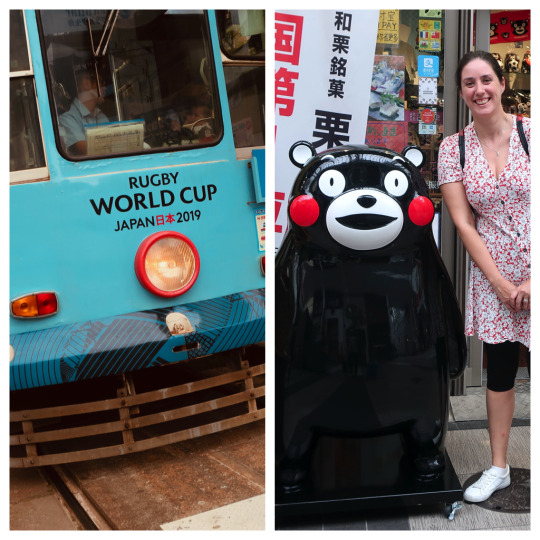
Kumamoto is also famous for its cuddly mascot Kumamon. It was originally designed to help publicise the opening of the shinkansen line in Kyushu. Within a year it had been voted the most popular mascot in Japan and was drawing visitors to Kumamoto prefecture. Part of the mascots success is that its image is licence free as long as it is promoting Kumamoto prefecture.
After a quick explore of Kumamoto we got on a bus for Nagasaki. At this point a typhoon was side swiping the coast so we were glad we were in a cosy bus for 3 hours. However it was still throwing it down when we got off the bus so we got suitably soaked getting to our hotel.
Nagasaki China Town
When the rain finally abated we ventured to Nagasaki’s China town. It is pretty small covering just one city block but is the oldest in Japan. Nagasaki was the only open port opened to trade during the Tokagawan period so the Chinese traders were the only foreigners along with the Dutch allowed into Japan. They were only allowed as far as the China town island and the Dutch were confined to Dejima.

The Portuguese influence
Our hotel was in the Portuguese style this is in homage to the Japo-Portugese heritage of Nagasaki. Until 1543 Nagasaki was a small fishing village. Then Portuguese explorers arrived and made contact. Soon after Portuguese ships became regular trade visitors opening Japan up to the rest of the world.

Nagasaki Peace Park
Nagasaki has a rich history at one point being regarded as the only window to the Western world, being the birthplace of Christianity in Japan through to being the site of the 27 crucified Japanese martyrs when the government decided to rid Japan of all foreign influence. It is also known in more recent history as being the place where 35,000 people were killed by an atomic bomb.
To ensure this horrific moment in history is not forgotten there is a museum and Peace park with statues sent from around the world engraved with promises of continued peace.

It is not as cohesively designed as Hiroshima’s Park but there are spaces away from the foreign offerings and artistic interpretations that are raw remnants that bring home the reality of what the place has witnessed. The black pillar signifying ground zero a stark reminder, the charred and broken remains of the cathedral’s arch a signal to the devastation.
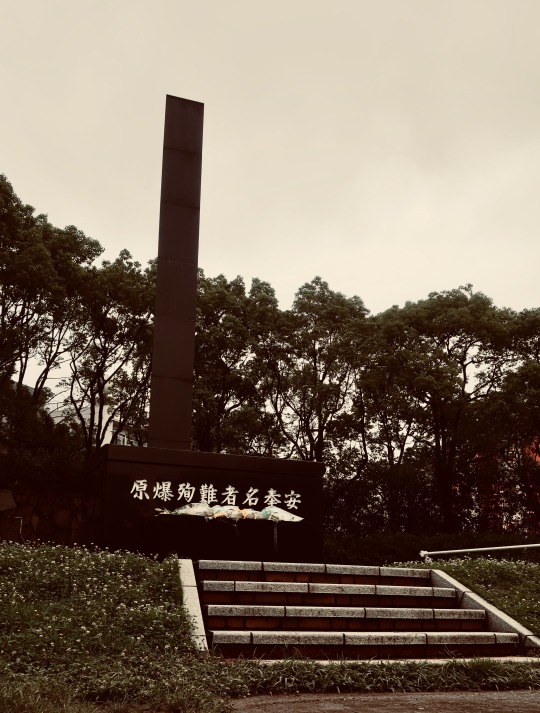

Next to these witnesses to history is a monument for hope, hung with the colourful symbols of peace the origami cranes. Opposite this is a relief which shares what must be learnt from this moment in history.

The women at home prayed for victory as their men departed for the battlefields. But then the blood of countless peoples was shed on the vast continents and the far away islands.
Finally in 1945 as the war escalated, it brought the tragedies of the Okinawa islands followed by the inhuman atomic bomb attacks over Hiroshima on the 5th and Nagasaki on the 9th of August.
Ah! Oh that unforgettable day, in an instantaneous blast of indescribable heat, the bodies of tens of thousands of men and women, mother and children were hideously burnt to death.
After more than forty years, the agony continues ever yet! Danger signs of a second nuclear war permeates our very existence. The earth stands at the brink of total Oblivion.
We must not allow anymore war! Nor the use of atomic weapons! Let us guard our precious green earth and preserve all life of every kind.
We erect this relief, still hearing the bursting cries on that day of each of those women long silenced in death. Bringing together all the turmoil from the depth of their tortured hearts and minds, we pledge ourselves never to repeat that disaster.
August 1, 1987
Nagasaki Museum of history and Culture
Hopping between rain showers we made it to the Nagasaki Museum of History and Culture which shares Nagasaki’s rich trading history. They even have a short interactive play that dramatises a dispute over a traditional boat race.
After absorbing as much history as we could we got a chance to play in the team lab where the walls and floors are interactive artwork.
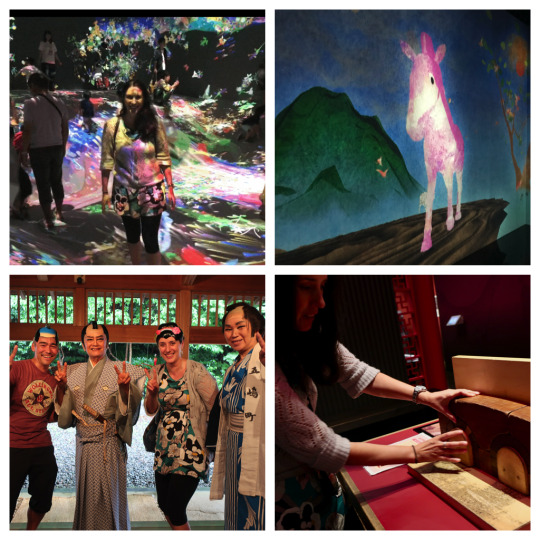
Meganebashi
Or Spectacles Bridge is one of seven bridges that stretches across Nakashima River in Nagasaki. It was originally built in 1634 with construction being overseen by a Chinese monk. It is a famous landmark in Nagasaki and popular with tourists due to its appearance of looking like spectacles when the bridge casts the right reflection in the river.

Our last day in Nagasaki we were lucky enough to have a local tour guide.
We got to see, Oura Church the the oldest standing Christian church in Japan. Glover gardens where Thomas Glover, a Scottish merchant had his home. Glover was an important figure in the development of industrial Japan. In fact from his dwelling you can see the original home of Mitsubishi Ship building.
We also got to taste Nagasaki delicacies as well as visiting Sofukuji Temple which was originally built for Nagasaki’s Chinese community. Lastly we visited the former Dutch trading station, Dejima.

There is much to see in Nagasaki - I think we gave it a good go. Apart from all its history it has great food particularly the Castella cakes, and fun nightlife.
#kumamoto#kumamon#nagasaki#nagasaki peace park#nagasaki museum#teamlab#meganebashi#glover garden#dejima#sofukuji#sushi
0 notes
Photo

キリスト級の歴史
長崎
長崎のキリスト教の歴史は、日本におけるキリスト教伝来の中心的な地域として知られています。以下に、長崎のキリスト教の歴史を要約します。
1. キリスト教の伝来:
16世紀半ば、ポルトガル商人たちと共にキリスト教宣教師が長崎に到来しました。フランシスコ・ザビエルなどの宣教師が活動し、日本人にキリスト教を布教しました。長崎は当時、外国船が入港する国際的な港であり、キリスト教が伝わりやすい環境でした。
2. キリスト教信仰の根付き:
長崎では、キリスト教が急速に広まりました。多くの人々が洗礼を受け、キリスト教の信仰を受け入れました。当時の大名や有力者たちもキリスト教に関心を示し、信仰の支持を行ったことで、キリスト教は比較的広く受け入れられました。
3. 宗教弾圧と隠れキリシタン:
17世紀初頭に、徳川家康の時代にキリスト教は徹底的に弾圧されました。キリスト教は禁止され、信仰を捨てないことは重い罰を受けることとなりました。多くの信者は隠れキリシタンとして信仰を秘密裏に続けました。長崎や周辺の地域には、隠れキリシタンが多く存在しました。
4. キリスト教の再興:
19世紀になると、キリスト教が再び復活し始めました。長崎の大浦天主堂など、多くの教会が建てられました。明治時代以降、キリスト教は公然と信仰されるようになり、現在では長崎は日本におけるキリスト教の中心地の一つとなっています。
♪���♬🎤🎹🎶♪♫♬🎤🎹🎶♪♫♬🎤🎹🎶♪♫♬🎤🎹🎶
christian history
Nagasaki
The history of Christianity in Nagasaki is known as the central region for the introduction of Christianity to Japan. The history of Christianity in Nagasaki is summarized below.
1. The introduction of Christianity:
In the mid-16th century, Christian missionaries arrived in Nagasaki along with Portuguese merchants. Missionaries such as Francis Xavier were active and spread Christianity to the Japanese people. At that time, Nagasaki was an international port where foreign ships entered, making it an environment where Christianity was easy to spread.
2. The roots of Christian faith:
Christianity spread rapidly in Nagasaki. Many people were baptized and accepted the Christian faith. The daimyo and influential people of the time also showed interest in Christianity and supported the faith, making Christianity relatively widely accepted.
3. Religious oppression and hidden Christians:
In the early 17th century, Christianity was severely suppressed during the reign of Tokugawa Ieyasu. Christianity was banned, and those who did not renounce their faith were subject to severe punishment. Many believers continued their faith in secret as Hidden Christians. There were many hidden Christians in Nagasaki and the surrounding areas.
4. Revival of Christianity:
In the 19th century, Christianity began to make a comeback. Many churches were built, including Oura Cathedral in Nagasaki. Since the Meiji period, Christianity has become an openly practiced religion, and today Nagasaki is one of the centers of Christianity in Japan.
0 notes
Photo

#nagasaki (Oura Cathedral) https://www.instagram.com/p/BxCQsF1ghwhBlTr-YnHE_t2pBptCoW2vADRopg0/?utm_source=ig_tumblr_share&igshid=k4fon1mz42ks
0 notes
Text
Day 2, 28th March, Nagasaki
Early morning breakfast for some of us only because we were up and ready to go and not because we had to. We arrived in the dark so now we could see what was around the hotel.
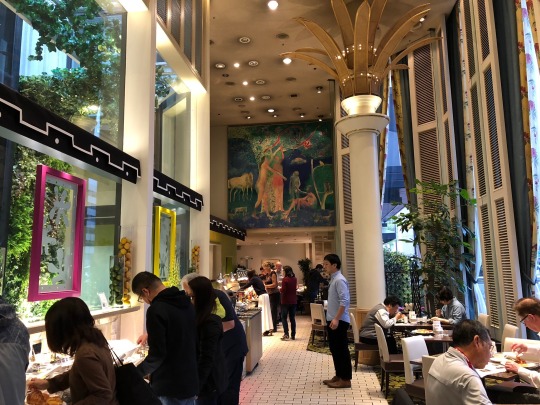
The first cherry blossom tree I have seen on this trip and it was across the road from the hotel.

Love the smart taxis around the place and I’m impressed by the suit and ties the drivers wear as well as the white lacy covers over the back of the seats.

People dress very well in Japan. Lots and lots of suits for the men

Traffic can be bad so you often see double and triple decked roads.

A pretty gray day to start. Down near the harbour where a big cruise ship was moored.

Cherry blossoms.

Typical sight seen in the countryside.

Venting machines are everywhere. This was at a stop we had along the way.
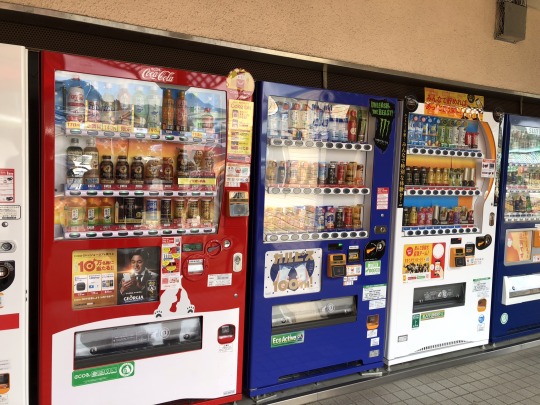
It seems to be common to see groups of men in suits travelling together.

Nagasaki Peace Park was built in 1955 on the epicentre of the Atomic bomb. Nagasaki wasn’t the original target but a city further west. However, the weather was overcast and the plane was running low on fuel so the pilot decided to drop the bomb on the city. 75,000 plus people were killed instantly. Many more died over the following months. The bomb landed on a gaol killing the 132 prisoners. All that is left are the gaols foundations.

Our first group photo in front of the Memorial Statue. The face is based on a Japanese but the body has a more muscular western body which refers to the fact the bomb can affect anyone. The finger pointing up is in fear of further bombs and the arm out to the side is indicating no more bombs. The eyes half shut is indicating meditation.
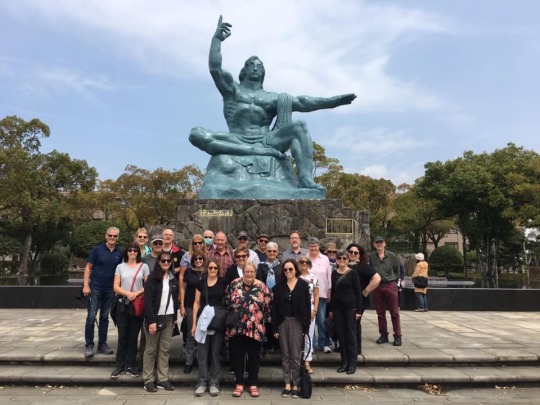
Crane memorial full of paper cranes.

Paper cranes for peace.
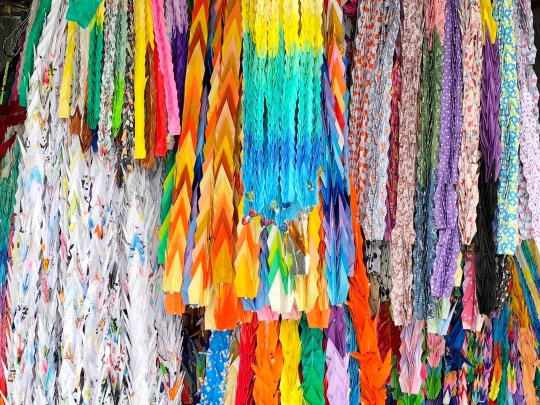
There was a lot of help for the city after the war from other parts of Japan as well as from many countries. There are a number of statues around the park indicating what countries gave help.
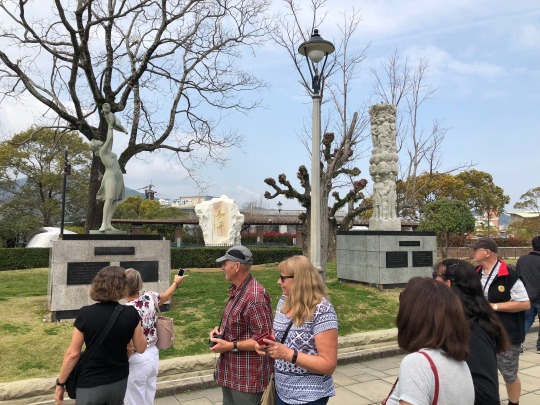
Angel wing fountain in the Park.
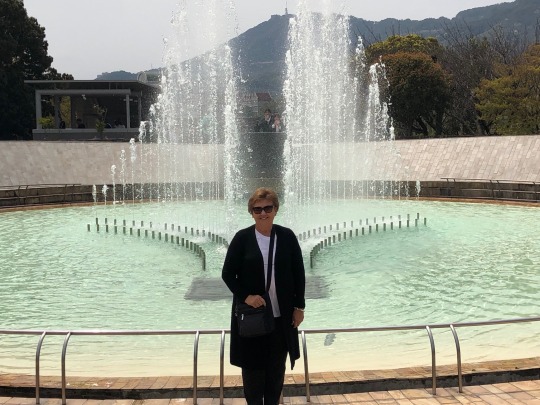
This man was 88 but was only 14 when the bomb was dropped. He was badly burnt and hit with glass. After he recovered he travelled to other parts of the world describing his experience. He spends time in the Park now talking to tourists. Water was a huge problem after the bomb drooped as it was in short supply and that was what all the survivors were begging for.
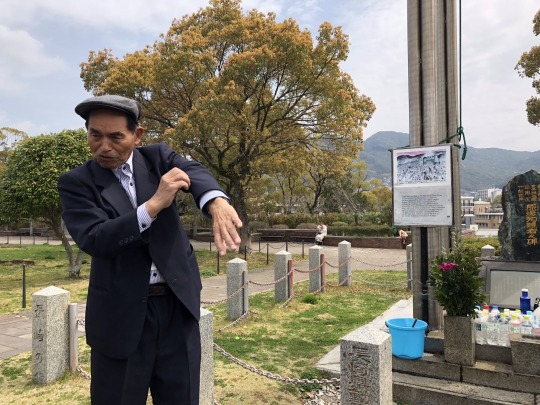
We watered the plants as an offering of water to the survivors.

Christine and Inosuke Hayasaki. He had been working at the Mitsubishi Arms Plant about 1.1kms north of the hypocenter. When the bomb dropped he was blown behind a pillar, which blocked the heat ray and the blast. Only the man and one other from 32 workers survived. His boss died on the spot.

Lovely flowers along the walkways.
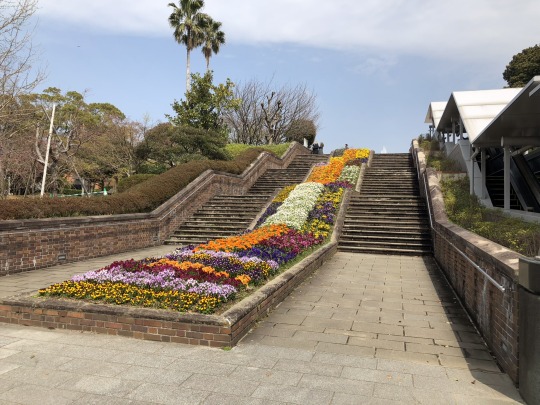
Al taking a photo of Balty.

This was a wall remanent from the Urakami Cathedral which was located about 500 metres northeast of the atomic bomb. The construction of the church began in 1895 and was completed in 1914. The wall was all that remained and was moved to the Peace Park.
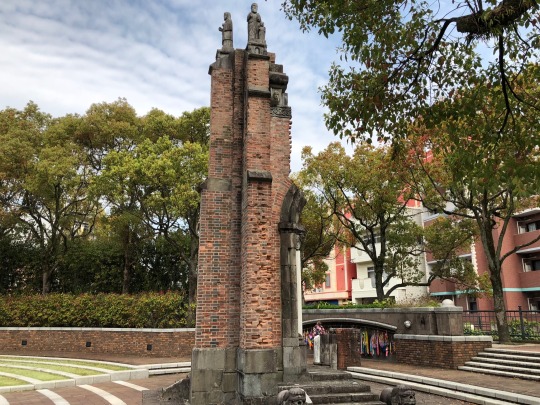
Memorial for those killed in the centre of where the bomb was dropped.

I think by the end of this trip we will be cherry blossomed out but the displays are beautiful.

Mother and child. A maternity hospital was hit by the bomb and this statue was erected in memory of the women and babies who were killed. The time and date of the bomb was listed underneath.

Group photo. Two in one day is a bit of a record and I think everyone was in both.

Nagasaki isn’t that attractive generally. It was pretty built up and gray looking.

Love these cute little van cars which are all over.

Everywhere you go there are always people wearing masks. Some to protect themselves against germs and also to protect other people from their germs.

For lunch we headed to a building with shops and lots and lots of restaurants. Each restaurant displayed the samples of their food but all done with plastic. There must be a big market for plastic food in Japan.
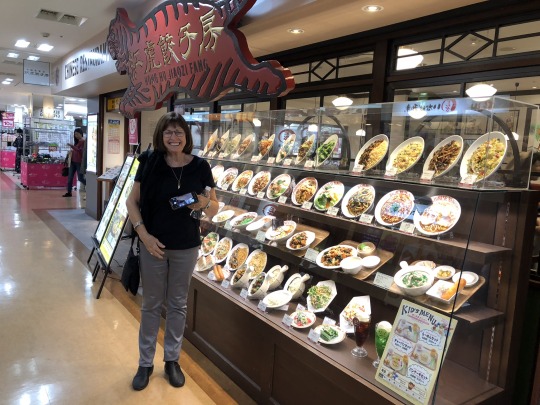
In 1571, Portuguese ships arrived at the harbour and since then Nagasaki has continued to develop as an international city. In 1636 under the orders of the Tokugawa Shogun, The Dejima was constructed by the efforts of 25 influential merchants at the tip of the cape of Nagasaki. The Portuguese were housed in the Dejima. Later the Dutch trading post in Hiradoat the time was moved to the Dejima and the exchange between Japan and Holland continued until the end of the Edo period. The Dejima fulfilled an important role as the only trading Port between Japan and Europe, the centre for Dutch study and the source for necessary information towards the modernisation of Japan.
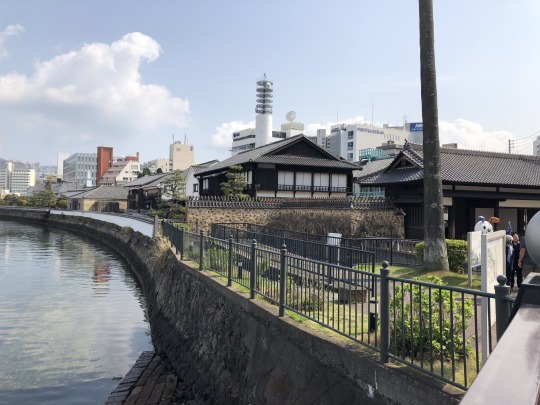
Samurais were warriors and worked for the Shoguns.
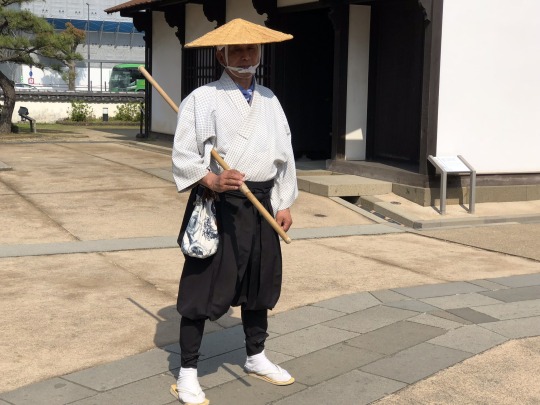
Chief Factor’s Residence

Lantern and hats.
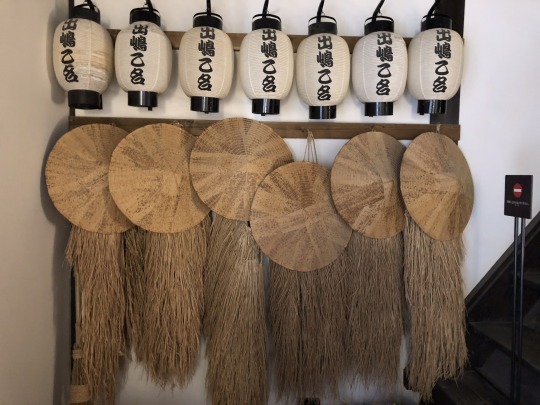
One of the old buildings housed activities from the past. This boy was enjoying drawing with a feather quill.

Walkways.

The former Dejima Protestant Seminary.
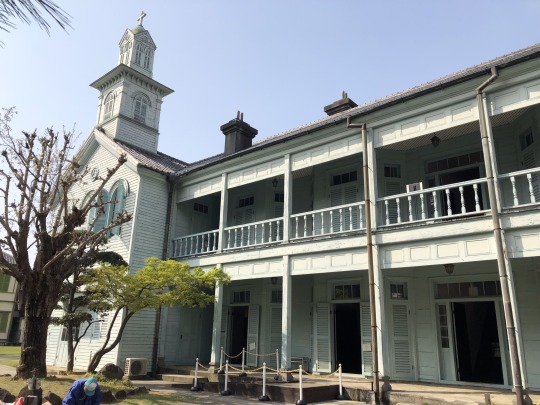
Lovely Japanese ladies in their kimonos.

Tulips which are remanents from the Dutch settlement.
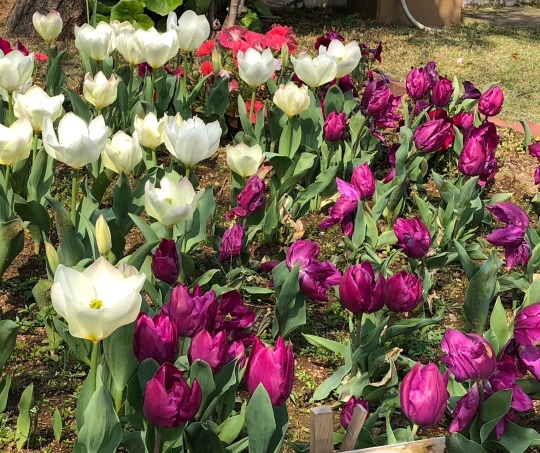
Friendly schoolboys in their military styled uniforms. Schools are on Spring Break at the moment. The holiday is usually longer but cut short this year because in May the Emperor is stepping aside for his son to become the new Emperor and there will be lots of National holidays during May. The new Emperor will be the 125 th Emperor since the 1st Century.

Old original wall of a garden. Sue and Cheryl in the background.
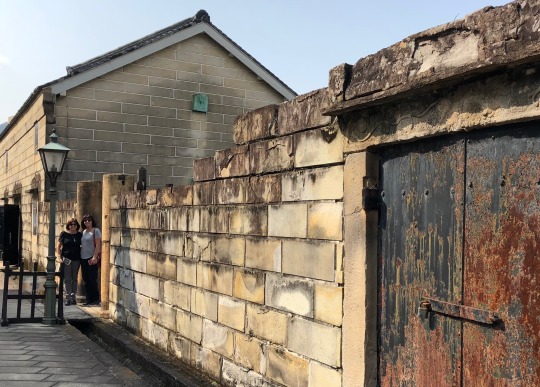
Oura Catholic Church which was built in 1875 by the Portuguese to provide a place of worship for Western traders.
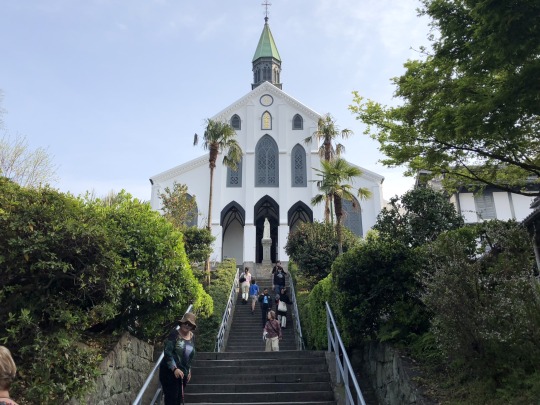
Coming out from prayer.

Looking up the side of the Church.
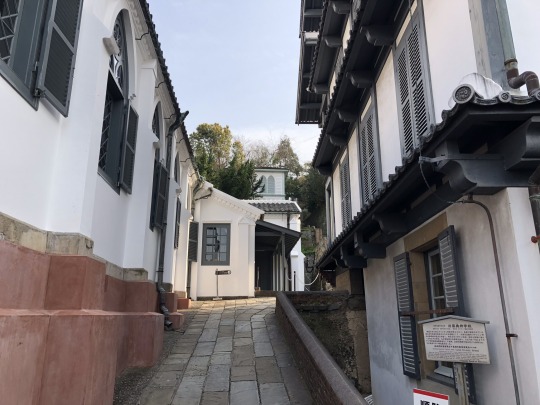
Gwenneth and John

Blossom.
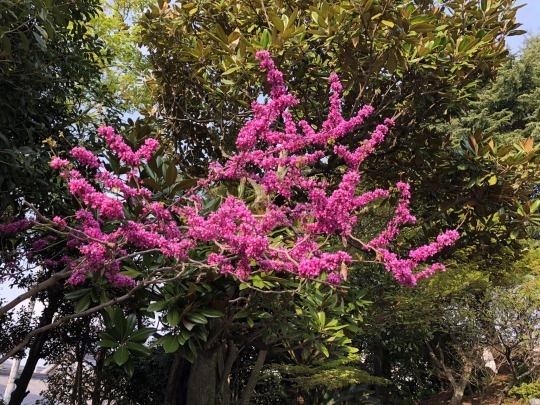
The group milling waiting to go into Glover Garden which was built for Thomas Blake Glover, a Scottish merchant who contributed to the modernization of Japan in shipbuilding, coal mining, and other fields. In it stands the Glover Residence, the oldest Western style house surviving in Japan.
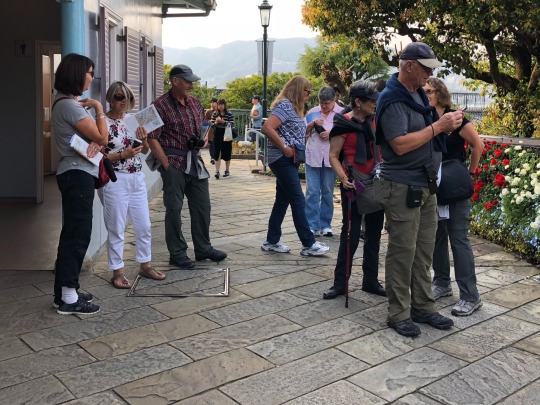
This building is now used as a tea room but was once a Jiyute (cafe).

Lovely walkways
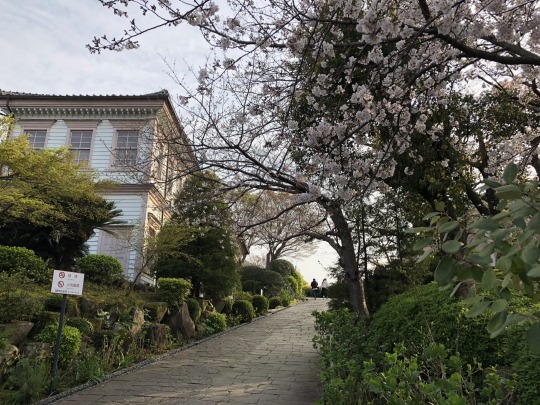
On one of the moving walkways that got us up the hill. There were two outside escalates and two moving walkways in the gardens so a very civilised way of getting up the hill.

Looking over part of the city.

Sara and I on the moving walkway.

This building,now on the top of the hill, was erected in 1898 and served as a domitory for crewmembers whilst their ship underwent repairs. It was known as the Mitsubishi No 2 Dock House. The building was originally adjacent to the dock of the Mitsubishi Nagasaki Shipyard.

The stunning blossoms certainly add colour to the gardens
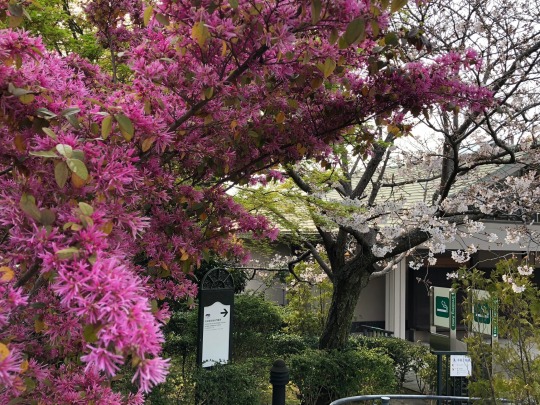
One of a number of lovely homes in the gardens.

Looking through the garden to the harbour. The gardens were beautiful. It was such a lovely area to walk through.

A statue of Madam Butterfly in the grounds of the garden. The story was based around this part of Japan.
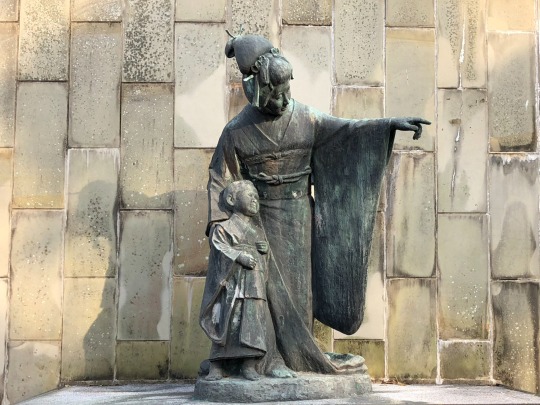
This was a big Holland America ship that was in port.ni can’t get away from these ships. There were quite a few westerners around the port. Japan doesn’t really have immigration or accepts refugees so it’s noticeable when you see anyone that isn’t Japanese.

0 notes